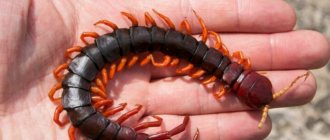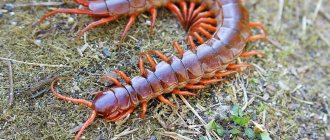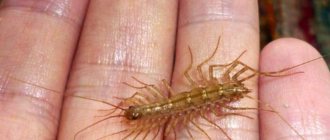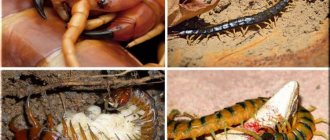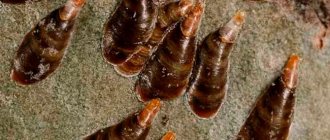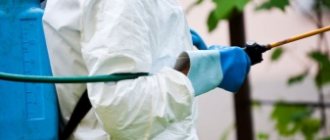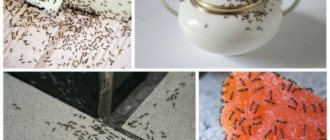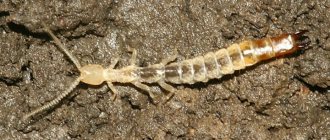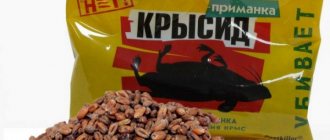Description
Scolopendra is an arthropod from the class of labiopods.
It is more common in countries and regions with tropical climates. In the wild, centipedes live in forests, mountains, and limestone caves. Ideal weather conditions for them are stable warmth and plenty of moisture.
The body of centipedes is long, narrow, segmented, each segment has a pair of legs. The first pair, located near the head, differs from the rest and are called maxillaries. Their purpose is to catch and hold prey. The last pair of legs is a kind of anchor necessary when moving.
Thanks to the faceted structure of the eyes, scolopendras have excellent spatial orientation. The body of arthropods is protected by a chitinous shell, which changes during molting.
The color of the body is protective; brown, light brown, grayish, brown, and black individuals are found. A greenish, orange or blue tint is possible. The shade depends on the habitat, species and age of the centipede.
Predatory centipedes feed on a variety of insects; giant species can catch amphibians, birds, snakes, and bats. Scolopendras are real long-livers. In favorable conditions, these arthropods can live up to 7 years.
They reach sexual maturity by 2 years; adult females lay up to 120 eggs after mating, but more than that do not survive. Young centipedes are born after a few months.
In Russia there is only one species of centipede - ringed or Crimean. This is a relatively small centipede up to 14 cm long, leading a predominantly nocturnal lifestyle. Under natural conditions, scolopendra can be found in the Crimea, the Caucasus, the Krasnodar Territory, the Volgograd and Rostov regions.
The ringed scolopendra is not aggressive, but can attack humans if disturbed. Most often, encounters take place in nature: centipedes crawl into tents and sleeping bags, and are found in firewood.
Sometimes Crimean centipedes are confused with other centipedes - flycatchers. These arthropods live in houses and apartments; they are not dangerous to humans.
The impact of the bite of the Crimean scolopendra
In order to kill a person, the bite of the Crimean scolopendra is not enough. This fact is encouraging, especially considering that this insect can accidentally settle in the house. The venom of the ringed centipede is not a threat to humans, although the bite itself is frightening and causes pain and unpleasant symptoms. Victims associate this pain as being stung by several bees at the same time. The poison becomes especially toxic in spring. First aid after a lesion should be immediate. The wound should be thoroughly rinsed with water, if possible. Next, it must be treated with any antiseptic (alcohol, chlorhexidine, miramistin). Apply a bandage, preferably sterile, and change it every 12 hours. It is also recommended to drink plenty of fluids (to quickly remove toxins from the body), remain calm, and not drink alcohol (it enhances the effect of toxins in the body).
The bite of the Black Sea scolopendra is manifested by the following consequences:
- Where the centipede bit, traces of tentacles are clearly visible - two punctures.
- Immediately after the bite, a burning sensation is felt, and then a sharp pain occurs.
- The skin around the affected area takes on a red tint.
- Swelling occurs and lasts for several days.
- There may be an increase in body temperature, a feeling of weakness, nausea and dizziness.
- Allergy sufferers most often experience a severe allergic reaction.
However, if you are bitten by a centipede while on vacation in Crimea, you should not be afraid; all symptoms after the bite will go away within a maximum of 2 days. If the affected person has an immune deficiency or is allergic, he should contact a medical facility for help. It is also necessary to visit a doctor if your health worsens - body temperature increases, malaise increases, and swelling occurs. After a poisonous centipede bite, you can take an antihistamine to relieve itching, swelling, redness, and apply special ointments or gels that relieve swelling and irritation on the skin.
Scolopendras in the garden and home: why are they dangerous?
Ideal conditions for arthropods: warmth, high humidity, darkness.
Scolopendra also attracts an abundance of insects: midges, wood lice, flies, moths. In regions with a warm and humid climate, scolopendra can be found in vegetable gardens and orchards. During dry summers the population decreases, but under favorable conditions their numbers increase. The increase in the number of arthropods is also influenced by the number of insects in the garden: the more there are, the more active the labiopod predators.
Gardeners are unanimous: it is not worth systematically destroying scolopendra in the garden. The ringed variety, living in Russia, prefers to lead a hidden lifestyle and does not pose a danger to humans and domestic animals. But it effectively destroys a variety of pests: flies, midges, whiteflies, spiders.
A variety of universal insecticides act on scolopendra. By exterminating pests, you can also destroy part of the population of predatory centipedes.
Centipedes enter houses and apartments through doors, windows, ventilation hatches, and basements. Most often they can be found in rooms on the ground and first floors, in bathrooms, storage rooms, and garages.
Large tropical varieties are quite poisonous, but ringed scolopendras are safe for humans. Moreover, their stings are very painful and the sensations are comparable to those of bees.
By biting through the skin, the scolopendra injects a portion of poison. There is redness, swelling and itching at the puncture site. Possible increase in temperature. The discomfort goes away after 2 days.
Scolopendras can cause a lot of problems for allergy sufferers. Venom glands are present on each pair of legs. Crawling across the skin, the arthropod leaves a swollen, painful mark.
Why is contact with her dangerous?
The sting of a scolopendra is similar in strength to a hornet sting and is very painful for humans. During a bite, it releases poison, which causes redness, swelling, and fever. In severe cases, nausea, vomiting, hallucinations, and enlarged lymph nodes appear.
Its poison is most toxic in spring.
Simple contact with scolopendra is also dangerous. Sensing danger, it secretes mucus, which causes irritation and redness of the skin. Remember: scolopendra is very aggressive and always attacks when feeling danger. You can’t just pick it up, it will definitely attack!
Hunts a scorpion
The scolopendra is especially dangerous at night, when the air temperature drops significantly and it goes out hunting. In Crimea, it can most often be seen in spring and early autumn; in summer, due to the heat, it is not so active. During its breeding season (which occurs at the beginning of spring), scolopendra is especially poisonous!
If after 1-2 days the condition of the bitten person does not improve, then it is advisable to seek help from a doctor. Sometimes the victim needs tetanus prophylaxis.
Prevention measures
In order not to attract scolopendras into your home, you must not create a favorable environment for them. For preventive purposes it is necessary:
- Clean up the area, getting rid of trash, fallen leaves, and cut branches. Place building materials and firewood in utility rooms.
- Destroy small insects - a nutritional source for centipedes. Any universal insecticide approved for use in residential premises will do.
- Eliminate cluttered corners, especially if they are located in dark places with high humidity. Clear out closets, storage areas in bathrooms and kitchens.
- Ventilate the bathroom more often and eliminate minor leaks. In conditions of increased dry air, millipedes quickly die.
- Seal the cracks through which scolopendras can enter the home with sealant. Pay special attention to windows, doors, cable openings, and siding cracks.
- Cover ventilation openings with fine-mesh mesh and protect windows with mosquito nets.
What to do if you are bitten?
If a person has been bitten by a large scolopendra, the following recommendations must be followed:
- wash the site of the bite or contact with the legs with soap, disinfect with available means (the best option is alcohol);
- apply a sterile bandage that needs to be changed every 10-12 hours;
- ensure plenty of fluids and rest;
- eliminate alcohol consumption;
- contact a specialist.
Pregnant women, children, people with diseases of the circulatory system and those with allergies should contact a medical facility immediately - in these cases the body is most susceptible to the effects of the poison.
Folk methods of struggle
Scolopendras are solitary pests; they rarely live in large colonies. Having found a centipede, you can suck it up with a vacuum cleaner or sweep it into a jar, close the lid and take it outside, away from the house. It is difficult to crush a large arthropod; for this you will need a shovel or other heavy object.
You should not rely on pets: cats and dogs are usually afraid of large centipedes and try to avoid them.
Expert opinion
Mityuk Stefania Bogdanovna
Boric acid, red pepper, chamomile powder and other methods do not work on scolopendra.
To detect and destroy scolopendra, you can place sticky traps near baseboards, cracks under furniture, thresholds and window sills. Any insect catching tape will do. Dead flies or spiders are suitable as bait. Sticky centipedes can be thrown away along with the tape; for safety, it is better to wear thick rubber gloves.
A reliable, but not very safe way is to scald the centipede with boiling water. This method is suitable for bathrooms or garages. The immobilized arthropod is removed using a scoop, protecting your hands with gloves.
How would you fight centipedes?
ChemicalFolk
Home keeping of scolopendra
Terrariums are used for breeding centipedes in captivity. This is a very mobile insect and at the same time aggressive. They live in captivity for up to seven years. If you have no experience in breeding centipedes, then it is best to study the literature and research all the safety precautions for their maintenance and breeding.
Scolopendra has a flexible pleural zone. Thanks to this fact, it can squeeze into the smallest cracks of any rocks and soil in order to hide securely. This centipede is the greatest escape specialist. When choosing a terrarium, pay attention to the length, width and height. Read the breeding guides; they contain the most complete information about such necessary things as buying a terrarium for centipedes. The soil must be moist and suitable for digging holes. There should be enough humidity, but it shouldn't be too wet.
Scolopendras are aggressive, but if you introduce crustacean woodlice, they will not touch them, since they do not perceive them as food.
Basically, for all types of centipedes, a temperature of 27 degrees is suitable. If you are getting a special species, consult with a specialist regarding temperature and housing conditions.
At home, it is advisable to feed scolopendra with grasshoppers or mealworms; overfeeding is not recommended. Usually they are fed 1-2 times a week. Scolopendra up to 15 cm in size will be satisfied with 5 crickets. Lack of appetite may mean that the insect is not hungry or is preparing for another molt.
Scolopendra is a poisonous animal belonging to the centipede family. She is famous for her terrifying appearance: most people feel horror and disgust when meeting her. But there are also those who keep scolopendra in a home terrarium and even let it out for a walk around the house.
Chemicals for pests
The most reliable way to get rid of centipedes and other centipedes is chemical insecticides. You should choose drugs of medium and low toxicity, suitable for use in residential areas. It is necessary to treat places where scolopendras are supposed to enter and live: basements, storage rooms, bathrooms.
Among the most effective means:
Insecticides in the form of a spray, the main active substances are permethrin and cypermethrin. The products are sprayed in areas where centipedes are expected to live. The spray will help immobilize an accidentally discovered scolopendra, after which it can be taken out of the room.
Powder containing up to 40% pure cypermethrin. Before use, dilute with water in accordance with the instructions. The solution is sprayed along baseboards, in corners, and at thresholds. After drying, the product becomes safe for people and pets. The protective effect lasts up to 3 months.
Dry powder that is scattered under furniture, along baseboards, under window sills. Safe for people and pets. It acts on centipedes gradually, drying out their body. At the same time, it destroys other crawling insects: various centipedes, woodlice, cockroaches.
Synthetic pyrethroid in the form of a liquid concentrate
Before spraying, dilute with water in the required proportion. The product is suitable for treating residential premises indoors and outdoors. For maximum effect, spray baseboards, cracks under windows, external walls near doorways, all kinds of holes and gaps. Avoid contact with skin and respiratory tract.
When working with toxic drugs, it is important to follow safety rules, protecting your face with a mask or respirator, and your hands with rubber gloves. Insecticides are harmful to children and pets. After treatment, it is necessary to ventilate the room.
If you notice a single centipede in an apartment, you should not panic. Perhaps the arthropod ended up here by chance and lives alone. You should not douse the entire room with insecticides: first you should do a general cleaning, ventilate the rooms and get rid of pests that can attract predatory centipedes.
General information about scolopendra
Domestic species of scolopendra reach a length of no more than six centimeters, unlike their relatives who prefer open areas. It has a yellow-gray color, sometimes with a tint of brown. On the back of the flattened body, which is divided into segments, there are three blue stripes.
The animal has many legs, and the first pair (in the form of pincers) serves to capture the victim, which is paralyzed by poison. Each leg is poisonous, which is why people get irritated after coming into contact with the centipede. The scolopendra feeds mainly on ants, flies, and cockroaches, and usually hunts alone at night.
In summer, females lay eggs in a damp and warm place. After some time, scolopendra larvae appear and grow throughout their lives. Since the outer cover of the centipede consists of chitin, the growth process is accompanied by constant molting.
